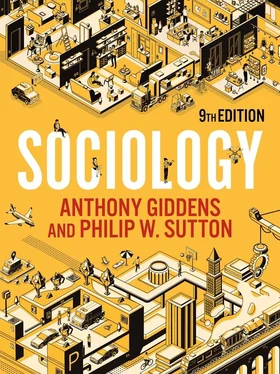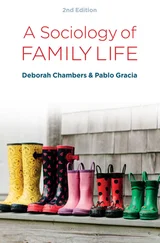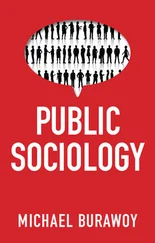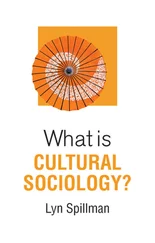
A sea of rooftop satellite dishes surround the Ben Salah mosque in Marrakech, Morocco. Digital technology enables companies, advertisers and cultural producers to reach every part of the world. Yet this does not inevitably mean the weakening of local cultures, beliefs and practices.
Global society 4.3 Reggae – a global musical style?
When those knowledgeable about popular music listen to a song, they can often pick out the stylistic influences that helped shape it. Each musical style, after all, represents a unique way of combining rhythm, melody, harmony and lyrics. And, while it does not take a genius to notice the differences between rock, rap or folk, for example, musicians often combine a number of styles in composing songs. Different musical styles tend to emerge from different social groups, and studying how these combine and fuse is a good way to chart the cultural contact between social groups.
Some sociologists turned their attention to reggae music because it exemplifies the process whereby contacts between social groups result in the creation of new musical forms. Reggae’s roots can be traced to West Africa. In the seventeenth century, large numbers of West Africans were enslaved by British colonists and brought by ship to work in the sugar-cane fields of the West Indies. Although the British attempted to prevent slaves from playing traditional African music for fear it would serve as a rallying cry to revolt, the slaves managed to keep alive the tradition of African drumming, sometimes by integrating it with European musical styles imposed by slave-owners. In Jamaica, the drumming of one group of slaves, the Burru, was openly tolerated by slave-owners because it helped meter the pace of their work. Slavery was finally abolished in Jamaica in 1834, but the tradition of Burru drumming continued, even as many Burru men migrated from rural areas to the slums of Kingston.
It was in these slums that a new religious cult began to emerge – one that would prove crucial to the development of reggae. In 1930, Haile Selassie was crowned emperor of Ethiopia. While opponents of European colonialism throughout the world cheered Selassie’s ascension to the throne, some in the West Indies came to believe that he was a god, sent to Earth to lead the oppressed of Africa to freedom. One of Selassie’s names was ‘Prince Ras Tafari’, and the West Indians who worshipped him called themselves ‘Rastafarians’. The Rastafarian cult soon merged with the Burru, and Rastafarian music combined Burru styles of drumming with biblical themes of oppression and liberation. In the 1950s, West Indian musicians began mixing Rastafarian rhythms and lyrics with elements of American jazz and black rhythm and blues. These combinations eventually developed first into ‘ska’ music and then, in the late 1960s, into reggae, with its relatively slow beat, its emphasis on bass and its stories of urban deprivation and of the power of collective social consciousness. Many reggae artists, such as Bob Marley, became commercial successes, and by the 1970s people the world over were listening to reggae music. In the 1980s and 1990s, reggae was fused with hip-hop (or rap) to produce new sounds (Hebdige 1997), heard in the work of the groups such as the Wu-Tang Clan, Shaggy or Sean Paul.
The history of reggae is thus the history of contact between different social groups and of the meanings – political, spiritual and personal – those groups expressed through their music. Globalization has increased the intensity of these contacts. It is now possible for a young musician in Scandinavia, for example, to grow up listening to music produced by men and women in the basements of Notting Hill in London and to be deeply influenced as well by, say, a mariachi performance broadcast live via satellite from Mexico City. If the number of contacts between groups is an important determinant of the pace of musical evolution, we can forecast that there will be a profusion of new styles in the coming years as the process of globalization develops.
Do your own research into the history and development of one current popular musical style, such as grime, hip-hop, K-pop, Arab pop, etc. Is this an example of musical globalization or are national influences more significant? What, if anything, does your example tell us about global-/glocalization?
There is some evidence that global forces may actually lead to the strengthening of traditional values and national identities. To capture the seemingly contradictory consequences of globalization, Robertson (1992) coined the term glocalization – a mixture of globalization and localization . Local communities are often active rather than passive in modifying and shaping global processes. Similarly, transnational companies tailor their products and services to take account of local conditions ‘on the ground’. If this is so, then we may find that globalization does not lead inevitably to a uniform, global (Western) culture but, instead, allows for diversity and multidirectional flows of cultural products across the world’s societies.
The Middle Eastern country of Kuwait is a traditional Islamic culture that recently experienced strong American and European influences. An oil-rich country on the Persian Gulf, Kuwait has one of the highest average per capita incomes in the world. The state provides free public education through to university level, resulting in high rates of literacy and education for both men and women. Kuwaiti television carries American football, with broadcasts interrupted for the traditional Muslim calls to prayer. Over 40 per cent of Kuwait’s people are under the age of twenty-five, and, like their counterparts in Europe and North America, many surf the internet and use the latest digital devices. In many respects, then, Kuwait is a wealthy ‘modern’ country, yet traditional gender norms remain that treat men and women differently. Women are generally expected to wear traditional clothing that leaves only the face and hands visible and are forbidden to leave home at night or to be seen in public with a man who is not a spouse or relative.
The internet is increasingly popular with young people, and interview data suggest that the main attraction is that it enables young people to cross strictly enforced gender lines. Deborah Wheeler’s (2006) interviews with male and female Kuwaiti students studying in the UK and the USA found that most reported communicating with the opposite sex as the most common use of the internet in a country which segregates men and women, even in internet cafés. One female student, Sabiha, reported that ‘The main reason [the] internet is so popular with the Kuwaiti youth is because it’s the most effective way for boys and girls to communicate with each other’ (Wheeler 2006: 148). Another interviewee, Buthayna, said that ‘Girls especially cannot form relationships with boys, even as friends in many families in Kuwait, so the internet is a “safe” place I guess for them to do so. And the fact that the two sides don’t know each other, they feel safer to voice their concerns, ideas, without having their reputations ruined or without it affecting their social life’ (ibid.: 146). However, other women reported that some wellknown chatrooms had themselves gained a ‘bad reputation’ for explicit conversation, and just using them now risked girls and young women attracting the label of ‘not being a decent girl’.
Kaposi (2014) reports that, in the period since Wheeler’s study, internet use and social media have become normalized and young people now find that their parents and relatives also participate. One respondent in this ethnographic study, Maryam, said, ‘I love Twitter. But now I’m starting to be careful with what I write, because of family and people I know starting to be there. It’s really hard because … these people are really conservative and I’m more open.’ Kaposi argues that this kind of online surveillance and community policing via gossip, rumour and reputational management shows just how porous is the boundary between online and offline worlds. It also shows that conventional interactional mechanisms from the physical social world, such as gossip, are not being superseded. Instead, they may be moving quite effortlessly into digital, online environments.
Читать дальше













